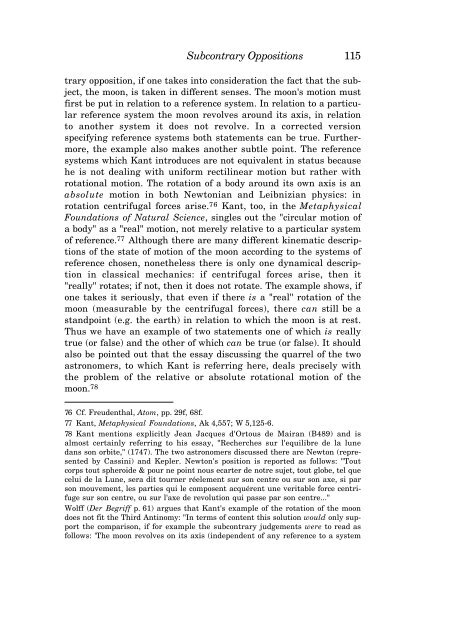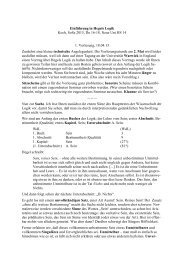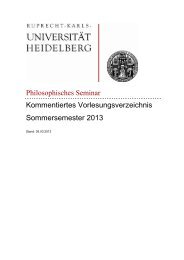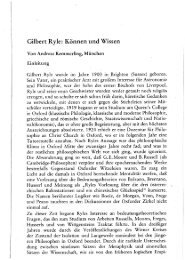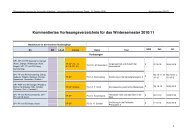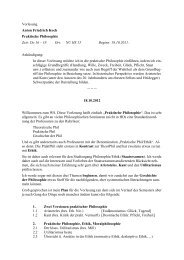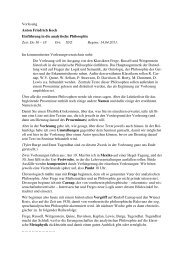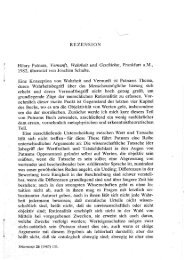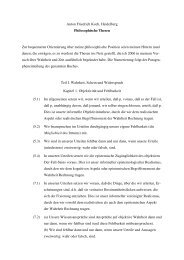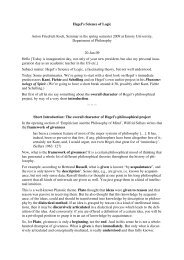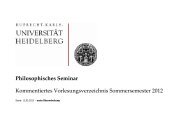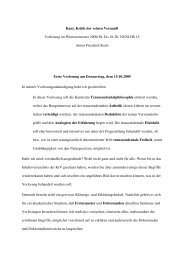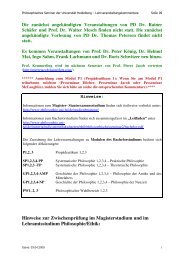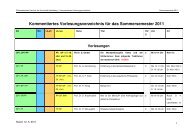KANT'S CRITIQUE OF TELEOLOGY IN BIOLOGICAL EXPLANATION
KANT'S CRITIQUE OF TELEOLOGY IN BIOLOGICAL EXPLANATION
KANT'S CRITIQUE OF TELEOLOGY IN BIOLOGICAL EXPLANATION
Create successful ePaper yourself
Turn your PDF publications into a flip-book with our unique Google optimized e-Paper software.
Subcontrary Oppositions 115<br />
trary opposition, if one takes into consideration the fact that the subject,<br />
the moon, is taken in different senses. The moon's motion must<br />
first be put in relation to a reference system. In relation to a particular<br />
reference system the moon revolves around its axis, in relation<br />
to another system it does not revolve. In a corrected version<br />
specifying reference systems both statements can be true. Furthermore,<br />
the example also makes another subtle point. The reference<br />
systems which Kant introduces are not equivalent in status because<br />
he is not dealing with uniform rectilinear motion but rather with<br />
rotational motion. The rotation of a body around its own axis is an<br />
absolute motion in both Newtonian and Leibnizian physics: in<br />
rotation centrifugal forces arise. 76 Kant, too, in the Metaphysical<br />
Foundations of Natural Science, singles out the "circular motion of<br />
a body" as a "real" motion, not merely relative to a particular system<br />
of reference. 77 Although there are many different kinematic descriptions<br />
of the state of motion of the moon according to the systems of<br />
reference chosen, nonetheless there is only one dynamical description<br />
in classical mechanics: if centrifugal forces arise, then it<br />
"really" rotates; if not, then it does not rotate. The example shows, if<br />
one takes it seriously, that even if there is a "real" rotation of the<br />
moon (measurable by the centrifugal forces), there can still be a<br />
standpoint (e.g. the earth) in relation to which the moon is at rest.<br />
Thus we have an example of two statements one of which is really<br />
true (or false) and the other of which can be true (or false). It should<br />
also be pointed out that the essay discussing the quarrel of the two<br />
astronomers, to which Kant is referring here, deals precisely with<br />
the problem of the relative or absolute rotational motion of the<br />
moon. 78<br />
76 Cf. Freudenthal, Atom, pp. 29f, 68f.<br />
77 Kant, Metaphysical Foundations, Ak 4,557; W 5,125-6.<br />
78 Kant mentions explicitly Jean Jacques d'Ortous de Mairan (B489) and is<br />
almost certainly referring to his essay, "Recherches sur l'equilibre de la lune<br />
dans son orbite," (1747). The two astronomers discussed there are Newton (represented<br />
by Cassini) and Kepler. Newton's position is reported as follows: "Tout<br />
corps tout spheroide & pour ne point nous ecarter de notre sujet, tout globe, tel que<br />
celui de la Lune, sera dit tourner réelement sur son centre ou sur son axe, si par<br />
son mouvement, les parties qui le composent acquérent une veritable force centrifuge<br />
sur son centre, ou sur l'axe de revolution qui passe par son centre..."<br />
Wolff (Der Begriff p. 61) argues that Kant's example of the rotation of the moon<br />
does not fit the Third Antinomy: "In terms of content this solution would only support<br />
the comparison, if for example the subcontrary judgements were to read as<br />
follows: 'The moon revolves on its axis (independent of any reference to a system


